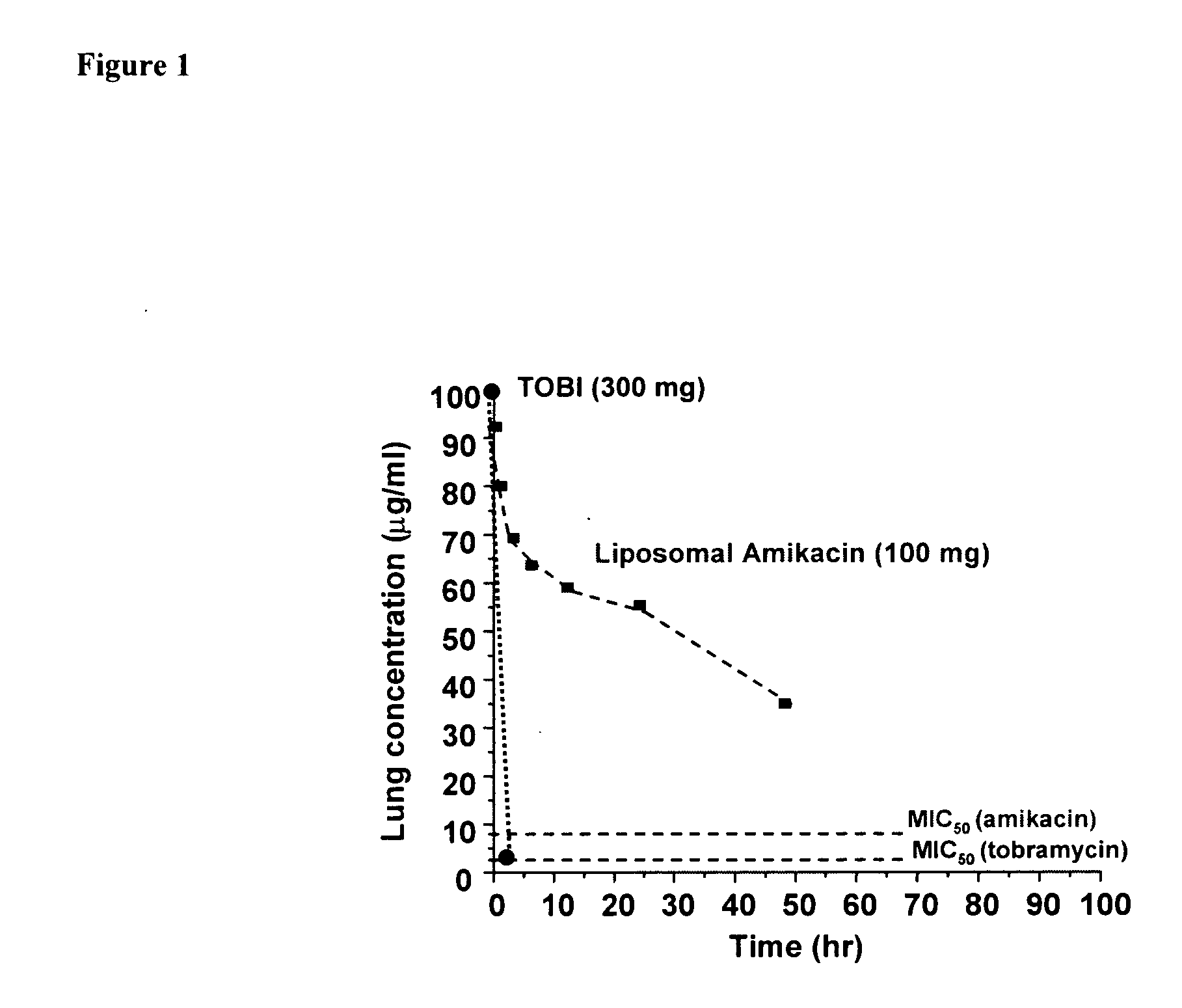Lipid-based compositions of antiinfectives for treating pulmonary infections and methods of use thereof
a technology of pulmonary infection and composition, which is applied in the direction of antibacterial agents, aerosol delivery, spray delivery, etc., can solve the problems of difficult to achieve sustained release of drugs in the lung, poor penetration of antiinfectives into the lung, and difficult regimens, so as to improve the therapeutic effect of antiinfectives
- Summary
- Abstract
- Description
- Claims
- Application Information
AI Technical Summary
Benefits of technology
Problems solved by technology
Method used
Image
Examples
example 1
[0096] Pharmacokinetics of amikacin delivered as both free and encapsulated amikacin in healthy volunteers. The nebulized liposomal amikacin contains a mixture of encapsulated (ca., 60%) and free amikacin (ca., 40%). Following inhalation in healthy volunteers the corrected nominal dose was 100 mg as determined by gamma scintigraphy. FIG. 1 depicts the lung concentration of amikacin and TOBI® (administered 100% free), based on pharmacokinetic modeling of serum concentrations over time. Both curves assume a volume of distribution for aminoglycosides in the lung of 200 ml. Interestingly, the peak levels of antiinfective in the lung are approximately equivalent for the 100 mg dose of liposomal amikacin, and the 300 mg dose of TOBI®. This is a consequence of the rapid clearance of the free, tobramycin from the lung by absorption into the systemic circulation with a half-life of about 1.5 hr. These results serve as a demonstration of the improved lung targeting afforded by liposomal encap...
example 2
[0097] Impact of free amikacin on the percentage of amikacin encapsulated in liposomes following nebulization. Liposomal preparations of amikacin may exhibit significant leakage of encapsulated drug during nebulization. As detailed in Table I below, the presence of free amikacin in solution was shown to surprisingly decrease the leakage of antiinfective by about four-fold from the liposome. While not wishing to be limited to any particular theory, it is hypothesized that liposomes break-up and re-form during nebulization, losing encapsulated antiinfective in the process. Alternatively, encapsulated antiinfective is lost during nebulization because the liposome membrane becomes leaky. When an excess of free antiinfective is present in solution, the free antiinfective is readily available in close proximity to the liposome, and is available to be taken back up into the liposome on re-formation.
TABLE 1Effect of free amikacin on the leakage of amikacin fromliposome-encapsulated amikac...
PUM
| Property | Measurement | Unit |
|---|---|---|
| absorption time | aaaaa | aaaaa |
| absorption time | aaaaa | aaaaa |
| volume | aaaaa | aaaaa |
Abstract
Description
Claims
Application Information
 Login to View More
Login to View More - R&D
- Intellectual Property
- Life Sciences
- Materials
- Tech Scout
- Unparalleled Data Quality
- Higher Quality Content
- 60% Fewer Hallucinations
Browse by: Latest US Patents, China's latest patents, Technical Efficacy Thesaurus, Application Domain, Technology Topic, Popular Technical Reports.
© 2025 PatSnap. All rights reserved.Legal|Privacy policy|Modern Slavery Act Transparency Statement|Sitemap|About US| Contact US: help@patsnap.com


